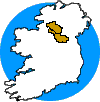
This region is situated along the north-eastern edge of the Namurian outlier of the Lough Allen Basin. The region can be divided into 2 distinct areas.
The first is the Belmore / Tullybrack area, north of Lough MacNean, with the limestone outcropping roughly north-south from Belcoo to Lough Navar, and the second is the Cuilcagh Mountain area, where the limestone outcrops in a roughly east-west line from Swanlinbar to beyond Blacklion.
The caves in the Tullybrack / Knockmore upland area are mostly vertical pot systems which enter extensive horizontal systems. Classic caves in the area include Pollaraftara, Noons-Archand Reyfad Pot, ( at -179m the deepest cave system in Ireland ). Some rising caves can be entered at resurgence level.
In the Cuilcagh Mountain area, deep, choked shafts in loose, chert-rich, limestones typify the eastern part of the limestone outcrop. Moving west, extensive active river systems such as Tullyhona, Prods-Cascades and Marble Arch are formed in pure carbonate mudbank-type limestones. In the western part of the limestone outcrop there are many systems where active exploration continues such as Pollnagossan, Ture Rising and Shannon Cave.
>Guidebooks
>Accommodation
There is only limited club accomodation in the Fermanagh/Cavan area. The Aghnahoo/Reyfad group hut is suitable for groups of up to 6. Marius Leonard has a number of excellent cottages at Corralea, Blacklion, Co Fermanagh.
Details on self-catering accomodation in the area can be obtained from the Northern Ireland Tourist Board, Tourist Information Centre, High Street, Belfast. or Bord Failte, Head Office, Baggot Street Bridge, DUBLIN 2. Local cavers tend to meet in Blacklion, Co. Cavan, in either The Bush Bar or Frank Eddie Maguire's.